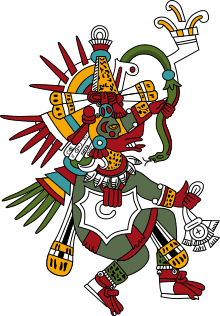Ōmeteōtl
Ōmeteōtl (Nahuatl pronunciation: [oːmeˈteoːt͡ɬ] (![]()
Definition
Multiple Nahuatl sources, notably the Florentine Codex, name the highest level of heaven Ōmeyōcān or "place of duality" (Sahagún specifically terms it "in ōmeyōcān in chiucnāuhnepaniuhcān" or "the place of duality, above the nine-tiered heavens)."[1] In the Histoyre du Mechique, Franciscan priest André Thevet translated a Nahuatl source reporting that in this layer of heaven there existed "a god named Ometecuhtli, which means two-gods, and one of them was a goddess."[2] The History of the Mexicans as Told by Their Paintings (Historia de los mexicanos por sus pinturas) names the inhabitants of the uppermost heaven Tōnacātēcuhtli and Tonacacihuatl (Lord and Lady of Abundance).[2] Sahagún concurs that these are epithets of "in ōmetēuctli in ōmecihuātl", giving as another name of ōmeyōcān "in tōnacātēuctli īchān" ("the mansion of the Lord of Abundance").[1]
There is some evidence that these two gods were considered aspects of a single being, as when a singer in the Cantares Mexicanos asks where he can go given that "ōme ihcac yehhuān Dios" ("they, God, stand double").[3] The Historia de los Mexicanos por sus pinturas reports of the two that "se criaron y estuvieron siempre en el treceno cielo, de cuyo principio no se supo jamás, sino de su estada y creación, que fue en el treceno cielo" (they were raised and had always been in the thirteenth heaven; nothing was ever known of their beginning, just their dwelling and creation, which were in the thirteenth heaven).[2]
As a result of these references, many scholars (most notably Miguel León-Portilla) interpret the rare name ōmeteōtl as "Dual God" or "Lord of the Duality". León-Portilla further argues that Ōmeteōtl was the supreme creator deity of the Aztecs, and that the Aztecs envisioned this deity as a mystical entity with a dual nature akin to the European concept of the trinity.[4] He argues that the Aztecs saw Ōmeteōtl as a transcendental deity and that this accounts for the scarcity of documentary references to it and the absence of evidence of an actual cult to Ōmeteōtl among the Aztecs.
Critique
Other scholars however, notably Richard Haly (1992), argue that there was no Ōmeteōtl, Omitecuhtli or Omecihuatl among the Aztecs. Instead, he claims, the names should be interpreted using the Nahuatl root omi ("bone"), rather than ōme ("two"). Haly further contends that Omitecuhtli was another name for Tonacatecuhtli and Mictlantecuhtli, both gods related to the creation of humans from dead bones. He argues that, of the five sources used by León-Portilla to argue in favor of the existence of a single creator god among the Aztecs, none contains a clear reference to a god of duality.
First, León-Portilla cites the Franciscan Fray Juan de Torquemada, who affirms in his chronicle that the "Indians wanted the divine Nature shared by two gods". In his translation of the Cantares Mexicanos León-Portilla introduces a reference to the "God of duality" where it is not explicitly found in the original text, which reads "ōme ihcac yehhuān Dios".[3] Haly argues that León-Portilla erroneously unites "stands dual" with the Spanish loanword Dios ("God") to invent this dual deity.[5][6] Another example given by León-Portilla is from the Historia Tolteca-Chichimeca: "ay ōmeteōtl ya tēyōcoyani", literally "two-god, creator of humanity."[7] Haly, reading the interjection ay as part of a longer (and similarly unattested) ayōmeteōtl, argues that this should rather be translated as "juicy maguey God" as the text talks about the imbibing of pulque. The Codex Ríos has a representation of a god labelled hometeule — iconographic analysis shows the deity Hometeule to be identical to Tonacatecuhtli.[8][9] The fifth source is the History of the Mexicans as Told by Their Paintings which Haly shows does not in fact read ōmeteōtl, but rather "omiteuctli, ("bone-lord") who is also called Maquizcoatl" and is explicitly stated to be identical to Huitzilopochtli.
Notes
References
- Anders, Ferdinand; Maarten Jansen; Luis Reyes García. Religión costumbres e historia de los antiguos mexicanos : libro explicativo del llamado Códice Vaticano A, Codex Vatic. Lat. 3738 de la Biblioteca Apostólica Vatican.
- Cantares Mexicanos: Songs of the Aztecs. Translated by Bierhorst, John. Stanford: Stanford University Press. 1985. ISBN 9780804711821.
- Garibay Kintana, Ángel Ma., ed. (1965). Teogonía e historia de los mexicanos: tres opúsculos del siglo xvi. Mexico City: Editorial Porrúa. ISBN 9789684323124.
- Haly, Richard (1992). "Bare Bones: Rethinking Mesoamerican Divinity". History of Religions. 31 (3): 269–304. doi:10.1086/463285.
- Kirchhoff, Paul; Odena Güemes, Lina; Reyes García, Luis, eds. (1989). Historia tolteca-chichimeca. Mexico City: Fondo de Cultura Económica. ISBN 9789681629038.
- León-Portilla, Miguel (1963). Aztec Thought and Culture: A Study of the Ancient Náhuatl Mind. Civilization of the American Indian series, no. 67. Jack Emory Davis (trans.) (translation and adaptation of: La filosofía náhuatl, 1st [1990] pbk reprint ed.). Norman: University of Oklahoma Press. ISBN 0-8061-2295-1. OCLC 23373512.
- León-Portilla, Miguel (1999). "Ometeotl, el supremo dios dual, y Tezcatlipoca "Dios Principal",". Estudios de Cultura Náhuatl. 30.
- Miller, Mary; Karl Taube (1993). The Gods and Symbols of Ancient Mexico and the Maya: An Illustrated Dictionary of Mesoamerican Religion. London: Thames & Hudson. ISBN 0-500-05068-6. OCLC 27667317.
- Payàs, Gertrudis (2004). "Translation in Historiography: The Garibay/León-Portilla Complex and the Making of a Pre-Hispanic Past" (PDF). Meta : journal des traducteurs / Meta: Translators' Journal. 49 (3): 544–561. doi:10.7202/009378ar.
- Sahagún, Bernadino (2012). Florentine Codex Book 6: Rhetoric and Moral Philosophy. Translated by Dibble, Charles E.; Anderson, Arthur J. O. Salt Lake City: University of Utah Press. ISBN 978-1607811619.
- Van Tuerenhout; Dirk R. (2005). The Aztecs: New Perspectives. ABC-CLIO's Understanding Ancient Civilizations series. Santa Barbara, CA: ABC-CLIO. ISBN 1-57607-921-X. OCLC 57641467.
- Wimmer, Alexis (2006). "Dictionnaire de la langue nahuatl classique" (online version, incorporating reproductions from Dictionnaire de la langue nahuatl ou mexicaine [1885], by Rémi Siméon). Retrieved 2009-07-14. (in French) (in Nahuatl languages)
